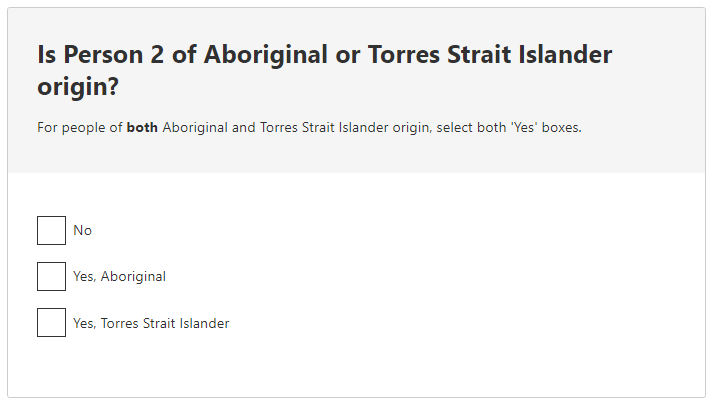Image

Description
Example
Image
Description
Example
Image

This variable records the response of persons who identified themselves as being of Australian Aboriginal and/or Torres Strait Islander origin in the Census.
All persons
| Code | Category |
|---|---|
| 1 | Non-Indigenous |
| 2 | Aboriginal |
| 3 | Torres Strait Islander |
| 4 | Both Aboriginal and Torres Strait Islander |
| & | Not stated |
| V | Overseas visitor |
Number of categories: 6
See Understanding supplementary codes for more information.
Responses are captured automatically from mark box responses on the form, so the risk of processing error is minimised. Where respondents identify as both Aboriginal and Torres Strait Islander, they are instructed to mark both the 'Yes, Aboriginal' and 'Yes, Torres Strait Islander' boxes. In cases where a respondent marked both ‘No’ and ‘Yes’ boxes, their Indigenous Status is set to ‘Not stated’.
In Australia, the method for collecting information about indigenous status is through self-identification. The ABS Standard Indigenous question is used in all ABS data collections. It is also used across a wide range of government agencies and Australian Aboriginal and Torres Strait Islander organisations. For more information please see the Indigenous Status Standard, 2014, Version 1.5.
The term Aboriginal and Torres Strait Islander 'origin' is used in the 2021 Census question. When used in the context of the ABS Standard Indigenous question it relates to a person's Australian Aboriginal and/or Torres Strait Islander descent and for some, but not all, their cultural identity.
Torres Strait Islander peoples come from the islands of the Torres Strait, between the tip of Cape York and Papua New Guinea.
Indigenous status data is available from the 1971 Census onwards. A question on origin has been asked in every Census. However, prior to the 1971 Census, Aboriginal peoples were counted in order to exclude them from population estimates for each state and territory.
The 1967 Referendum changed section 127 of the Constitution to allow Aboriginal people to be included in official Census population counts. The 1971 and 1976 censuses asked each person's racial origin. Since the 1981 Census the word 'racial' has been dropped from the question. The 1996 Census was the first Census to allow people's origins to be recorded as both Aboriginal and Torres Strait Islander, prior to this only one or the other could be recorded.
No changes have been made for 2021.
Changes in Indigenous status between censuses can affect the interpretation of Census data for Aboriginal and Torres Strait Islander peoples. It is important to remember that Indigenous status is collected through self-identification and any change in how a person chooses to identify will affect the count of Aboriginal and Torres Strait Islander peoples in the Census.
The non-response rate for Indigenous status (INGP) was 4.9% in 2021. This is a decrease from 6.0% in 2016.